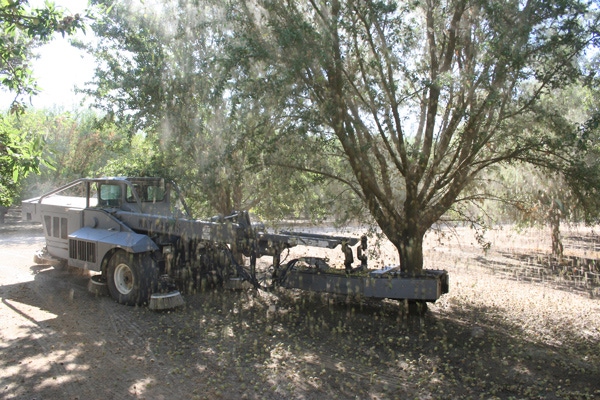
Pollinators unlikely to make up for drop in this year’s Merced County Nonpareil production
“I’m telling farmers that if their Nonpareil yields are close to last year, they’re doing better than most,” says David Doll, the county’s University of California Cooperative Extension farm advisor for tree nuts.

With Merced County 2014’s almond harvest expected to finish in early October, the Nonpareil crop came in smaller than growers had anticipated at the start of the season. That reflects the trend throughout California’s Central Valley orchards.
“I’m telling farmers that if their Nonpareil yields are close to last year, they’re doing better than most,” says David Doll, the county’s University of California Cooperative Extension farm advisor for tree nuts. “Depending on location, production is off anywhere from 5 percent to 20 percent from a year ago. That seems to be consistent with the industry, overall.”
One reason, of course, is the on-going drought and greater reliance on groundwater for irrigation, as deliveries of higher-quality surface water have been reduced or stopped altogether. The degree of water shortage varied across the county due to the differing water districts. But, most farmers were impacted, Doll notes.
Although some growers report filling a similar number of trailers with nuts from their fields as they did in 2013, smaller kernel sizes reduced the weight of nuts delivered to processors this year.
This could be caused by the drought, soil salinity problems or a less-than-adequate number of chilling hours the trees received this past winter, he explains.
“The timing of the bloom was odd and strung out, affecting production,” Doll says. “We’re seeing that in other tree crops, like walnuts, cherries and peaches, this year, too.”
Lack of winter rains to leach out a buildup of salts in the root zones from increased use of groundwater is also keeping yields down, he notes.
Initially, salts accumulating in the root zone affect the osmotic flow of water into root cells. This forces the tree to spend some of the energy, normally used to produce nuts, to take up water. The result is stunted growth.
At higher soil-salinity levels, the tree begins taking up these salts. This leads to scorching, killing and dropping of leaves and, in severe cases, loss of fruiting wood. After several years of exposure to high salt concentrations, trees will die, Doll notes.
From what he’s seen in his field visits, hopes that pollinator yields would help offset some of the drop in Nonpareil production don’t’ seem to be panning out. However, Doll is usually called to check an orchard only when a problem develops.
Want the latest agricultural news each day? Click here for the Western Farm Press Daily e-mail newsletter.
“There’s a lot of new acreage out there,” Doll says. “In our rootstock trials this year, a few fourth-leaf root stocks yielded nearly 1,700 pounds per acre,” Doll says. “That’s really good but the salinity issues in these young trees were minimal. I’ve also seen turn-outs from other farmer's fourth-leaf orchards yielding higher than that."
In terms of nut quality, including kernel size, results of this year’s harvest have varied widely, he reports.
Some of his growers report heavy damage from navel orangeworm. Overall, though, this pest did not pose the major threat many had feared at the start of the season. That concern was prompted by warmer-than-normal weather, which fuels growth of insect populations. Generally, many growers in the industry followed good pest management practices, including sanitation and early harvest, Doll says.
Hull rot was on the rise this year in Nonpareil, apparently due to very humid weather during hull split, he adds. In addition, in a number of cases, Monterey and Carmel exhibited symptoms similar to hull rot. “This condition is different than hull rot,” he explains. “But, we don’t know what it is – we are working on it.”
As September neared end, most Merced County growers where shaking the trees of their two latest-maturing varieties Monterey and Fritz.
Once the harvest is completed, growers can turn their attention to fertilizing their orchards with nitrogen and, if needed, boron and irrigating their orchards.
Now is a good time to develop a plan for managing high soil salinity levels, Doll notes. He advises periodic applications of both water to flush out salts and calcium to displace sodium on exchange site of soil particles. “Calcium treatments, usually with gypsum, have proven effective in various agronomic crops and carries over to almonds and walnuts,” Doll says. “In addition to the physical benefits to the soil, research suggests that it also improves the root’s ability to exclude sodium and reduce its uptake.”
About the Author(s)
You May Also Like



